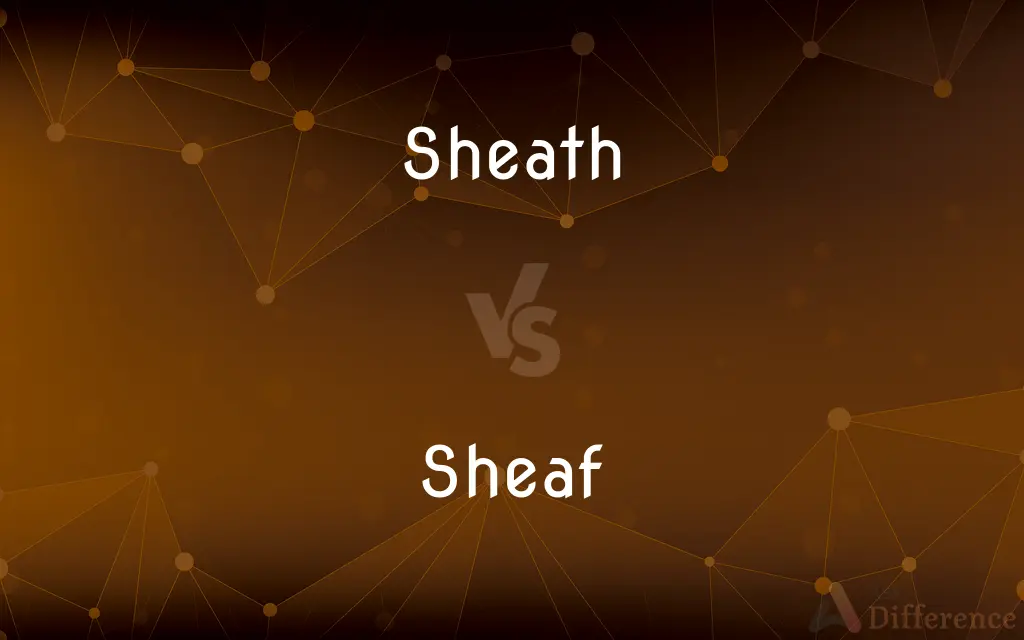Sheath vs. Sheaf — What's the Difference?
Edited by Tayyaba Rehman — By Maham Liaqat — Updated on April 20, 2024
A sheath is a protective covering, often for a blade or tool, while a sheaf is a bundle of objects bound together, typically stalks of grain.

Difference Between Sheath and Sheaf
Table of Contents
ADVERTISEMENT
Key Differences
A sheath is primarily used as a cover or case for a knife, sword, or similar tool, protecting both the blade and the user. On the other hand, a sheaf refers to a collection of items, usually agricultural like grain or wheat, that are tied together for easy handling and storage.
Sheaths are crafted from various materials including leather, metal, and synthetic fabrics, tailored to securely encase and protect the shape of a blade. In contrast, sheaves are typically bound with twine or another flexible material, emphasizing functionality over form, meant to consolidate and organize loose stalks.
The term "sheath" can also extend metaphorically to describe any form of protective covering in biology or technology, such as the sheath around a cable. Whereas, "sheaf" may also be used in a figurative sense in mathematics or literature, indicating a collection or bundle of similar items or concepts.
In use, a sheath is vital for safety, ensuring that sharp edges are covered when not in active use, thereby preventing accidents. A sheaf, however, is primarily about storage and transport efficiency, making bulk items like harvested grain easier to move and process.
While both sheath and sheaf imply containment, the sheath is singular and protective, focusing on preserving the condition of something potentially dangerous. Sheaf, on the other hand, deals with practicality and bulk management, grouping multiple items into a single manageable unit.
ADVERTISEMENT
Comparison Chart
Definition
A cover for a blade or tool.
A bundle of objects, typically grain, tied together.
Material
Leather, metal, synthetic fabrics.
Twine, rope.
Function
Protects and houses sharp instruments.
Organizes and consolidates bulk materials.
Usage
Safety in handling knives, swords, etc.
Efficiency in agriculture and storage.
Metaphorical Use
Biological and technological protective coverings.
Collections or bundles in various disciplines.
Compare with Definitions
Sheath
Can denote the structure surrounding and protecting something sensitive.
The plant's roots were covered by a natural sheath that retains moisture.
Sheaf
Can indicate any grouped set of similar objects or entities.
The artist presented a sheaf of sketches to the gallery owner for review.
Sheath
A protective case for a knife, sword, or similar tool.
He slid the knife back into its leather sheath after cutting the rope.
Sheaf
Used to organize large quantities of similar items.
Sheaves of paper were stacked high in the printer room.
Sheath
Any covering that closely envelops another object.
The cable's sheath was designed to prevent electrical leaks.
Sheaf
Literary or figurative use to describe collections of writings or documents.
She compiled a sheaf of her poems to share with the class.
Sheath
Used metaphorically to describe protective layers in biology.
The nerve is encased in a protective sheath that shields it from damage.
Sheaf
A bundle of grain or similar materials tied together.
The farmer gathered the wheat into several large sheaves for threshing.
Sheath
Often tailor-made to fit the dimensions of the object it protects.
The custom sheath for the sword was crafted from hardened steel.
Sheaf
In mathematics, refers to a structure that condenses complex data sets.
In topology, a sheaf provides a method for systematically compiling local data.
Sheath
A close-fitting cover for the blade of a knife or sword.
Sheaf
A bundle of cut stalks of grain or similar plants bound with straw or twine.
Sheath
A usually close-fitting case or covering for a blade, as of a sword.
Sheaf
A collection of items held or bound together
A sheaf of printouts.
Sheath
Any of various similar coverings.
Sheaf
An archer's quiver.
Sheath
(Biology) An enveloping tubular structure, such as the base of a grass leaf that surrounds the stem or the tissue that encloses a muscle or nerve fiber.
Sheaf
To gather and bind into a bundle.
Sheath
A close-fitting dress.
Sheaf
A quantity of the stalks and ears of wheat, rye, or other grain, bound together; a bundle of grain or straw.
Sheath
A condom.
Sheaf
Any collection of things bound together.
A sheaf of paper
Sheath
A holster for a sword; a scabbard.
Sheaf
A bundle of arrows sufficient to fill a quiver, or the allowance of each archer.
Sheath
(by extension) Anything that has a similar shape to a scabbard that is used to hold an object that is longer than it is wide.
Sheaf
A quantity of arrows, usually twenty-four.
Sheath
(botany) The base of a leaf when sheathing or investing a branch or stem, as in grasses.
Sheaf
(mechanical) A sheave.
Sheath
(electrical engineering) The insulating outer cover of an electrical cable.
Sheaf
(mathematics) An abstract construct in topology that associates data to the open sets of a topological space, together with well-defined restrictions from larger to smaller open sets, subject to the condition that compatible data on overlapping open sets corresponds, via the restrictions, to a unique datum on the union of the open sets.
Sheath
(entomology) One of the elytra of an insect.
Sheaf
(transitive) To gather and bind into a sheaf; to make into sheaves
To sheaf wheat
Sheath
(fashion) A tight-fitting dress.
Sheaf
(intransitive) To collect and bind cut grain, or the like; to make sheaves.
Sheath
(zoology) The foreskin of certain animals (for example, dogs and horses).
Sheaf
A sheave.
Sheath
A condom.
Sheaf
A quantity of the stalks and ears of wheat, rye, or other grain, bound together; a bundle of grain or straw.
The reaper fills his greedy hands,And binds the golden sheaves in brittle bands.
Sheath
Alternative spelling of sheathe
Sheaf
Any collection of things bound together; a bundle; specifically, a bundle of arrows sufficient to fill a quiver, or the allowance of each archer, - usually twenty-four.
The sheaf of arrows shook and rattled in the case.
Sheath
A case for the reception of a sword, hunting knife, or other long and slender instrument; a scabbard.
The dead knight's sword out of his sheath he drew.
Sheaf
To gather and bind into a sheaf; to make into sheaves; as, to sheaf wheat.
Sheath
Any sheathlike covering, organ, or part.
Sheaf
To collect and bind cut grain, or the like; to make sheaves.
They that reap must sheaf and bind.
Sheath
A protective covering for a knife or sword
Sheaf
A package of several things tied together for carrying or storing
Sheath
An enveloping structure or covering enclosing an animal or plant organ or part
Sheath
A dress suitable for formal occasions
Common Curiosities
Are sheaths used for objects other than weapons?
Yes, sheaths can be used for any elongated tool requiring protection, including technical instruments and delicate probes.
What is the primary purpose of a sheath?
The primary purpose of a sheath is to provide protection for both the blade it covers and the user handling it.
Can a sheaf be anything other than agricultural products?
Yes, while traditionally associated with agriculture, "sheaf" can broadly apply to any grouped set of similar items, like documents.
How does the concept of a sheaf extend into mathematics?
In mathematics, a sheaf is a tool for systematically collating data that varies across a space, particularly used in topology and algebraic geometry.
What advantages does bundling into sheaves provide in agriculture?
Bundling into sheaves allows for more efficient handling, transport, and processing of bulk agricultural products like grain.
What are the typical materials used to make a sheath?
Typical materials for a sheath include leather, metal, and synthetic fabrics, chosen for durability and protective qualities.
What features are important in the design of a sheath?
Important features include a snug fit, durable material, and sometimes a locking mechanism to secure the blade.
What are some non-traditional uses of sheaf in other disciplines?
Beyond agriculture, "sheaf" is used in fields like document management, literary collections, and various mathematical contexts.
What role does a sheath play in maintaining tool safety?
A sheath is essential for tool safety as it prevents accidental cuts and preserves the tool’s condition by protecting the blade.
How do sheaths and sheaves compare in terms of cultural significance?
Sheaths hold cultural significance in contexts related to craftsmanship and safety, whereas sheaves are more connected to agricultural practices and seasonal traditions.
How do materials impact the function of a sheath?
The material of a sheath affects its durability, protective ability, and suitability for different environmental conditions.
Is a sheath always designed for carrying?
While often designed for safe carrying, sheaths are also crucial for storage, maintaining the condition of the protected item.
How does the sheaf concept apply to document storage?
In document storage, sheaves refer to the bundling of papers or files that are systematically grouped for organizational efficiency.
Can sheaves be used for decoration or ceremonial purposes?
Yes, sheaves, especially those made of grain or flowers, can be used decoratively or in ceremonial settings like harvest festivals.
How is a sheaf useful in mathematical research?
In mathematics, a sheaf is useful for compiling localized data into a coherent whole, facilitating complex analysis.
Share Your Discovery

Previous Comparison
Underbridge vs. Overbridge
Next Comparison
Creaky vs. RicketyAuthor Spotlight
Written by
Maham LiaqatEdited by
Tayyaba RehmanTayyaba Rehman is a distinguished writer, currently serving as a primary contributor to askdifference.com. As a researcher in semantics and etymology, Tayyaba's passion for the complexity of languages and their distinctions has found a perfect home on the platform. Tayyaba delves into the intricacies of language, distinguishing between commonly confused words and phrases, thereby providing clarity for readers worldwide.
















































